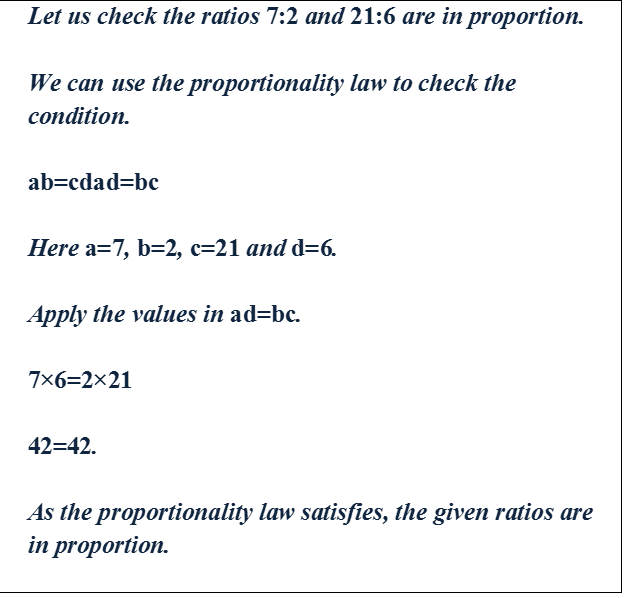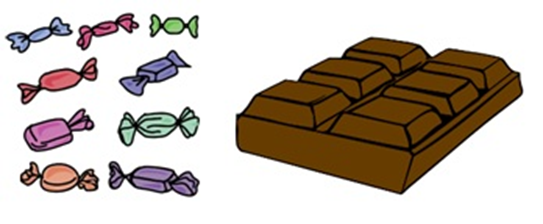- Books Name
- Class 6 Mathematics Book
- Publication
- ReginaTagebücher
- Course
- CBSE Class 6
- Subject
- Mathmatics
Proportion and Unitary Method
Concept of proportion,
However, we say that they're in proportion and use the If two ratios are equal.
Symbol ‘’ or ‘=’ to equate the two ratios. Four quantities are said to be in proportion, if the ratio of the first and the second quantities is equal to the ratio of the third and the fourth quantities.|
e.g., we can say 2, 10, 5, and 25 are in proportion that is written as 2 10 5 25 and is read as 2 is to 10 as 5 is to 25 or it has written as 2 10 = 5 25.
However, then we say that they are not in proportion, If two ratios are not equal.
In a statement of proportion, the four quantities involved when taken in order are known as respective terms. First and fourth terms are known as extreme terms. Second and third terms are known as middle terms. In the above example, 2 and 25 are extreme terms while 10 and 5 are middle terms.
Proportionality law
When two ratios are in proportion a: b:: c:d, then the product of the extremes is equal to the product of the means. This is called the proportionality law.
Here 'a' and ’d’ are the extreme values and 'b' and 'c' are the mean values.
In addition, if two ratios are equal, then they can be related as follows.
ab=cdad=bc
It is called the cross product of proportion.
It says that 'when two ratios are in proportion a:b::c:d, then the product of the extremes is equal to the product of the means'

Unitary method,
The method in which we first find the value of one unit and then the value of the required number of units is called as the unitary method.
If the value of 4 pencils is Rs40, what is the value of one pencil?

Value of 4 pencils = Rs. 40
Value of 1 pencil = 40/4
= Rs.10
The value of one pencil is Rs.10. Now it is possible to calculate the price of any required number of units.
If we want to calculate the value of 100 pencils then:
Value of 1 pencil = Rs.10
Value of 100 pencils = 10*10 = Rs.100
Following examples further explain this method.
Problem: If it has rained 276 mm in the last 3 days, how many cm of rain will fall in one full week (7 days)? Assume that the rain continues to fall at the same rate.

Solution:
Amount of rain in the last 3 days = 276mm
Amount of rain in 1 day = 276/3
Amount of rain in 1 day = 92 mm
Amount of rain in a week = Amount of rain in 7 days
Amount of rain in 7 days = 7*(Amount of rain in 1 day)
= 7*92
Amount of rain in 7 days = 644 mm.
Problem: A truck requires 108 litres of diesel for covering a distance of 594 km. How much diesel will be required by the truck to cover a distance of 1650 km?

Litres of diesel used in covering 594 km = 108 litres
Litres of diesel used in covering 1km = 108/594
= 0.1818 litres
Litres of diesel required in covering 1650 kms
= 1650*(litres of diesel used to cover 1 km)
Litres of diesel required in covering 1650 kms = 1650*0.1818
= 299.97 litres.
= 300 litres (Apporx.)
Application of ratios
Problem: Cost of a toffee is 50 paise and cost of a chocolate is Rs 10. Find the ratio of the cost of a toffee to the cost of a chocolate.

Solution: As mentioned above, it is important that both the quantities be in the same unit for comparison.
Cost of a toffee = 50 paise
Cost of a chocolate = Rs. 10
= 1000 paise (Rs. 1 = 100 paise)
Cost of a toffee/ Cost of a chocolate = 50/1000 = 1/20
Thus, the ratio is 1:20
Problem: Out of 30 students in a class, 6 like football, 12 like cricket and remaining like tennis. Find the ratio of Number of students liking football to number of students liking tennis.

Solution: Number of students that like football = 6
Number of students that tennis = Total students – No. of students that like cricket – No. of students that like football
Number of students that like tennis = 30-12-6 = 12
Number of students that like football/ Number of students that like tennis
= 6/12 = 1/2
Thus, the required ratio is 1:2.
Problem: Cost of a dozen pens is Rs 180 and cost of 8 ball pens is Rs 56. Find the ratio of the cost of a pen to the cost of a ball pen.

Solution:
Cost of a dozen pens = Rs.180
Number of pens in a dozen = 12
Cost of 12 pens = Rs180
Cost of 1 pen = 180/12 = Rs.15
Cost of 8 ball pens = Rs.56
Cost of 1 ball pen = Rs.56/8 = Rs. 7
The ratio of the cost of a pen to the cost of a ball pen is:
Cost of a pen/ Cost of a ball pen = 15/7
Therefore, the required ratio is 15:7.
Problem: Mother wants to divide Rs 36 between her daughters Shreya and Bhoomika in the ratio of their ages. If age of Shreya is 15 years and age of Bhoomika is 12 years, find how much Shreya and Bhoomika will get.

Solution:
Age of Shreya = 15 years
Age of Bhoomika = 12 years
Therefore, the two parts of the ratio are 15 and 12.
Since, we can get equivalent ratios by multiplying or dividing the numerator and denominator by the same number. 3 can divide 15 and 11 and we can get the two parts of the ratio as 5 and 4.
Therefore, sum of these parts = 5 + 4 = 9
This means if there is Rs 9, Shreya will get Rs 5 and Bhoomika will get Rs.4.
Alternatively, we can say that Kriti gets 5 parts and Bhoomika gets 4 parts out of every 9 parts.
Therefore, Shreya’s share = 5/9
And Bhoomika’s share = 4/9
Out of given Rs.36:
Shreya’s Share = 5* 36/9 = 5*4 = 20.
Bhoomika’s Share = 4* 36/9 = 4*4 = 16.
Thus, their shares are Rs.20 and Rs.16.

 Param Publication
Param Publication
 ReginaTagebücher
ReginaTagebücher
